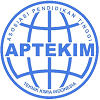Sintesis Zn-BDC dengan Metode Sonokimia dan Aplikasinya Pada Proses Adsorpsi Ion Logam Pb2+
Abstract
The heavy metal ion pollution such as lead (Pb2+) in wastewater is an environmental problem that needs to be solved. The adsorption method has been reported to have good potential as an alternative method for reducing heavy metal contents in aquatic environment. The most widely used adsorbent media are porous materials with a large surface area and low density. Metal Organic Frameworks (MOFs) are a type of porous material that is widely applied in various fields, such as fuel purification, solvent recovery, gas storage, and adsorbents. Lead(II) is a heavy metal ion that can pollute the environment and endanger humans. This study aims to synthesize MOFs and apply it to the Pb2+ adsorption process. In this research, MOFs type Zn-BDC or MOF-5 were synthesized by sonochemistry method at 60 ℃ as adsorbent for Pb2+ ion. Characterization of the adsorbent by FTIR showed the presence of functional groups C=O, C-H, and Zn-O which indicated the formation of the MOF-5 compound. The concentrations of Pb2+ ions were analyzed using Atomic Absorption Spectrophotometer (AAS). The experimental results show the optimum conditions for the adsorption process at pH 5 for 60 minutes with adsorption efficiency reaching 93.41%. Testing the adsorption isotherm model showed that the Pb2+ ion adsorption process using Zn-BDC as an adsorbent followed the Langmuir isotherm model with the R2 value of 0.9986.
Keywords
Full Text:
PDFReferences
N. Yuan, X. Gong, W. Sun, and C. Yu, “Advanced applications of Zr-based MOFs in the removal of water pollutants,” Chemosphere, vol. 267. Elsevier Ltd, Mar. 01, 2021. doi: 10.1016/j.chemosphere.2020.128863.
A. T. Jan, M. Azam, K. Siddiqui, A. Ali, I. Choi, and Q. M. R. Haq, “Heavy metals and human health: Mechanistic insight into toxicity and counter defense system of antioxidants,” International Journal of Molecular Sciences, vol. 16, no. 12. MDPI AG, pp. 29592–29630, Dec. 10, 2015. doi: 10.3390/ijms161226183.
S. Ashraf, Q. Ali, Z. A. Zahir, S. Ashraf, and H. N. Asghar, “Phytoremediation: Environmentally sustainable way for reclamation of heavy metal polluted soils,” Ecotoxicology and Environmental Safety, vol. 174. Academic Press, pp. 714–727, Jun. 15, 2019. doi: 10.1016/j.ecoenv.2019.02.068.
Z. Kovacova, S. Demcak, and M. Balintova, “Removal of Copper from Water Solutions by Adsorption on Spruce Sawdust,” Jul. 2019, p. 52. doi: 10.3390/proceedings2019016052.
Y. Zheng, F. Rao, M. Zhang, J. Li, and W. Huang, “Efficient, selective, and reusable metal–organic framework-based adsorbent for the removal of Pb(II) and Cr(VI) heavy-metal pollutants from wastewater,” Cleaner Engineering and Technology, vol. 5, Dec. 2021, doi: 10.1016/j.clet.2021.100344.
A. H. Hashem, E. Saied, and M. S. Hasanin, “Green and ecofriendly bio-removal of methylene blue dye from aqueous solution using biologically activated banana peel waste,” Sustainable Chemistry and Pharmacy, vol. 18, Dec. 2020, doi: 10.1016/j.scp.2020.100333.
Z. liang Liao, Z. chao Zhao, J. cheng Zhu, H. Chen, and D. zong Meng, “Complexing characteristics between Cu(Ⅱ) ions and dissolved organic matter in combined sewer overflows: Implications for the removal of heavy metals by enhanced coagulation,” Chemosphere, vol. 265, Feb. 2021, doi: 10.1016/j.chemosphere.2020.129023.
M. Bazrgar Bajestani, A. Moheb, and M. Dinari, “Preparation of lithium ion-selective cation exchange membrane for lithium recovery from sodium contaminated lithium bromide solution by electrodialysis process,” Desalination, vol. 486, Jul. 2020, doi: 10.1016/j.desal.2020.114476.
D. P. Rocha, A. L. Squissato, S. M. da Silva, E. M. Richter, and R. A. A. Munoz, “Improved electrochemical detection of metals in biological samples using 3D-printed electrode: Chemical/electrochemical treatment exposes carbon-black conductive sites,” Electrochimica Acta, vol. 335, Mar. 2020, doi: 10.1016/j.electacta.2020.135688.
P. S. Chauhan, R. Kant, A. Rai, A. Gupta, and S. Bhattacharya, “Facile synthesis of ZnO/GO nanoflowers over Si substrate for improved photocatalytic decolorization of MB dye and industrial wastewater under solar irradiation,” Materials Science in Semiconductor Processing, vol. 89, pp. 6–17, Jan. 2019, doi: 10.1016/j.mssp.2018.08.022.
Y. Zheng, F. Rao, M. Zhang, J. Li, and W. Huang, “Efficient, selective, and reusable metal–organic framework-based adsorbent for the removal of Pb(II) and Cr(VI) heavy-metal pollutants from wastewater,” Cleaner Engineering and Technology, vol. 5, Dec. 2021, doi: 10.1016/j.clet.2021.100344.
X. He et al., “Cerium(IV) Enhances the Catalytic Oxidation Activity of Single-Site Cu Active Sites in MOFs,” ACS Catalysis, vol. 10, no. 14, pp. 7820–7825, Jul. 2020, doi: 10.1021/acscatal.0c02493.
E. Burgaz, A. Erciyes, M. Andac, and O. Andac, “Synthesis and characterization of nano-sized metal organic framework-5 (MOF-5) by using consecutive combination of ultrasound and microwave irradiation methods,” Inorganica Chimica Acta, vol. 485, pp. 118–124, Jan. 2019, doi: 10.1016/j.ica.2018.10.014.
D. Chen, W. Shen, S. Wu, C. Chen, X. Luo, and L. Guo, “Ion exchange induced removal of Pb(II) by MOF-derived magnetic inorganic sorbents,” Nanoscale, vol. 8, no. 13, pp. 7172–7179, Apr. 2016, doi: 10.1039/c6nr00695g.
K. Xie, C. Shan, J. Qi, S. Qiao, Q. Zeng, and L. Zhang, “Study of adsorptive removal of phenol by MOF-5,” Desalination and Water Treatment, vol. 54, no. 3, pp. 654–659, Apr. 2015, doi: 10.1080/19443994.2014.886292.
M. el Kassaoui, M. Lakhal, A. Benyoussef, A. el Kenz, and M. Loulidi, “Effect of zinc substitution by magnesium and cadmium on hydrogen storage properties of connector-metal-organic framework-5,” Journal of Alloys and Compounds, vol. 874, Sep. 2021, doi: 10.1016/j.jallcom.2021.159902.
C. Ben-Youssef, A. Chávez-Yam, A. Zepeda, J. M. Rivera, and S. Rincón, “Simultaneous esterification/transesterification of waste cooking oil and Jatropha curcas oil with MOF-5 as a heterogeneous acid catalyst,” International Journal of Environmental Science and Technology, vol. 18, no. 11, pp. 3313–3326, Nov. 2021, doi: 10.1007/s13762-020-03088-y.
G. Kumar and D. T. Masram, “Sustainable Synthesis of MOF-5@GO Nanocomposites for Efficient Removal of Rhodamine B from Water,” ACS Omega, vol. 6, no. 14, pp. 9587–9599, Apr. 2021, doi: 10.1021/acsomega.1c00143.
J. Bedia, V. Muelas-Ramos, M. Peñas-Garzón, A. Gómez-Avilés, J. J. Rodríguez, and C. Belver, “A review on the synthesis and characterization of metal organic frameworks for photocatalytic water purification,” Catalysts, vol. 9, no. 1. MDPI, Jan. 01, 2019. doi: 10.3390/catal9010052.
K. Yu, Y. R. Lee, J. Y. Seo, K. Y. Baek, Y. M. Chung, and W. S. Ahn, “Sonochemical synthesis of Zr-based porphyrinic MOF-525 and MOF-545: Enhancement in catalytic and adsorption properties,” Microporous and Mesoporous Materials, vol. 316, Mar. 2021, doi: 10.1016/j.micromeso.2021.110985.
P. George, R. K. Das, and P. Chowdhury, “Facile microwave synthesis of Ca-BDC metal organic framework for adsorption and controlled release of Curcumin,” Microporous and Mesoporous Materials, vol. 281, pp. 161–171, Jun. 2019, doi: 10.1016/j.micromeso.2019.02.028.
S. Wang, X. Xie, W. Xia, J. Cui, S. Zhang, and X. Du, “Study on the structure activity relationship of the crystal MOF-5 synthesis, thermal stability and N2adsorption property,” High Temperature Materials and Processes, vol. 39, no. 2020, pp. 171–177, Jan. 2020, doi: 10.1515/htmp-2020-0034.
F. Haftan, M. Kazemi, and N. The, “The sorbent based on MOF-5 and its polyurethane nanocomposite for copper adsorption from aqueous solution sorbent based on MOF-5 and its polyurethane nanocomposite for copper adsorption from aqueous solution,” Nanomed Res J, vol. 6, no. 3, pp. 287–295, 2021, doi: 10.22034/nmrj.2021.03.009.
H. Zhu, J. Yuan, X. Tan, W. Zhang, M. Fang, and X. Wang, “Efficient removal of Pb 2+ by Tb-MOFs: identifying the adsorption mechanism through experimental and theoretical investigations,” Environmental Science: Nano, vol. 6, no. 1, pp. 261–272, 2019, doi: 10.1039/c8en01066h.
K. Wang, J. Gu, and N. Yin, “Efficient Removal of Pb(II) and Cd(II) Using NH2-Functionalized Zr-MOFs via Rapid Microwave-Promoted Synthesis,” Industrial and Engineering Chemistry Research, vol. 56, no. 7, pp. 1880–1887, Feb. 2017, doi: 10.1021/acs.iecr.6b04997.
Refbacks
- There are currently no refbacks.











_-_Copy.png)

